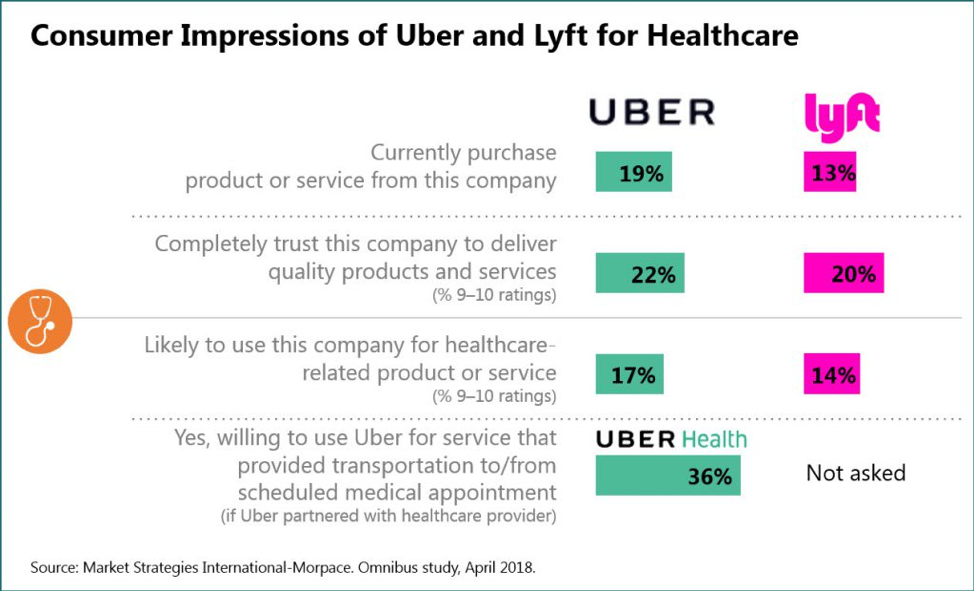Editor’s note: Christine Diani is director, research and consulting – health care, at market research firm Market Strategies International, Portland, Ore. This is an edited version of a post that originally appeared under the title, “Will Uber Health and Lyft Concierge change healthcare?”
 This year Uber and Lyft formally entered the health care market to offer ride-share services to non-emergency patients for transportation to scheduled doctor appointments. Patient no-shows are a prevalent problem in the U.S., with an estimated 3.6 million Americans reportedly missing their scheduled doctor appointments due to transportation issues each year. Ride-share services may particularly benefit older Americans, Medicaid patients and those with chronic diseases to help keep appointments and get care. Uber and Lyft have identified a wide-open opportunity that could significantly improve their business and simultaneously reduce health care costs and improve quality care.
This year Uber and Lyft formally entered the health care market to offer ride-share services to non-emergency patients for transportation to scheduled doctor appointments. Patient no-shows are a prevalent problem in the U.S., with an estimated 3.6 million Americans reportedly missing their scheduled doctor appointments due to transportation issues each year. Ride-share services may particularly benefit older Americans, Medicaid patients and those with chronic diseases to help keep appointments and get care. Uber and Lyft have identified a wide-open opportunity that could significantly improve their business and simultaneously reduce health care costs and improve quality care.
How Uber and Lyft are expanding
Uber Health entered the health care market in March 2018 by partnering with health care organizations to provide transportation services for patients. Providers access the Uber Health dashboard to order and schedule ride-share services, and patients can use the services even if they don’t have access to a smartphone or Uber app because health care providers can manage the ride scheduling and billing through Uber’s dashboard.
Lyft followed suit shortly after the launch of Uber Health by offering a health care ride-share platform called Lyft Concierge. Lyft partnered with Allscripts, the largest electronic health systems provider, to request Lyft rides for patients directly through an integrated platform. Lyft recently expanded its reach by partnering with Formativ Health to provide non-emergency rides for patients. This partnership puts Lyft Concierge into Formativ’s patient engagement platform, enabling Formativ’s roughly 250 patient engagement specialists to book rides for patients in more than 40 states.
Both companies are going to lengths to strongly position and promote their health care ride-share services by minimizing the effort needed to use them. In Lyft’s case, it has opted to fully integrate its services into the fabric of the health care systems. It will be interesting to see which company succeeds and the overall impact of the health care ride-share services on both brands.
Will ride-share services for patients work?
While there is debate on whether ride-share services effectively reduce the number of patient no-shows, our quantitative research team recently completed a study conducted among 1,003 consumers nationwide suggesting patient ride-share services are a significant opportunity that is likely to grow in popularity. The study reports that nearly two in 10 consumers are very likely to use a health care transportation service from Uber or Lyft if offered.

Further, nearly four in 10 consumers say they are willing to use Uber for medical appointment transportation, demonstrating a large potential market for this type of service. Currently, the greatest barrier to using Uber is a lack of trust in the Uber drivers – something Uber is actively working to address. If the customer-centric efforts being taken by both Uber and Lyft are successful, our results suggest that consumers have the appetite and need to try nontraditional transportation approaches for their health care visits. Given these findings we expect Uber and Lyft to impact a reduction of no-shows via their expanded medical ride-share services.
The impact of successful ride-share services on health care
At this point, our study shows Uber only slightly leading over Lyft, with no clear competitive advantage of one over the other. This healthy competition between Uber and Lyft can improve access to care, reduce health care costs and achieve better health-quality outcomes. The success of ride-share services translates to more patients keeping their appointments and fewer patients relying on more expensive transportation services and care such as ambulances and ER visits. Ultimately, improving transportation for health care will yield better care for patients and improve administrative operations and bottom lines for hospitals, providers and insurers. Tackling the large transportation barrier with Uber and Lyft services could be the perfect opportunity to move health care in a positive direction.
About the study
Market Strategies-Morpace interviewed a national sample of 1,003 consumers ages 18 and older from April 4 to 6, 2018. Respondents were recruited from the Full Circle opt-in online panel of U.S. adults and interviewed online. The data were weighted by age and gender to match the demographics of the U.S. population. Due to its opt-in nature, this online panel does not yield a random probability sample of the target population. As such, it is not possible to compute a margin of error or to statistically quantify the accuracy of projections. Market Strategies will supply the exact wording of any survey question upon request.
